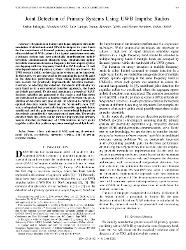| dc.contributor.author | Erküçük, Serhat | |
| dc.contributor.author | Lampe, Lutz | |
| dc.contributor.author | Schober, Robert | |
| dc.date.accessioned | 2019-06-27T08:04:51Z | |
| dc.date.available | 2019-06-27T08:04:51Z | |
| dc.date.issued | 2011 | |
| dc.identifier.issn | 1536-1276 | en_US |
| dc.identifier.issn | 1558-2248 | en_US |
| dc.identifier.uri | https://hdl.handle.net/20.500.12469/998 | |
| dc.identifier.uri | https://doi.org/10.1109/TWC.2011.122010.100990 | |
| dc.description.abstract | Regulation in Europe and Japan requires the implementation of detect-and-avoid (DAA) techniques in some bands for the coexistence of licensed primary systems and secondary ultra wideband (UWB) systems. In a typical coexistence scenario a primary system may have potentially interdependent uplink-downlink communication channels (e. g. simultaneous uplink-downlink communications in a frequency division duplex system) overlapping with the frequency band of a UWB system. If such interdependencies of primary systems' activities are known the UWB system's ability to detect primary systems can be improved. In this study we are interested in determining the possible gains in the detection performance when taking interdependencies into account for practically implementable detection methods. Contrary to selecting the detection thresholds individually for each band as in a conventional detection approach the bands are jointly processed. To this end maximum a posteriori (MAP) decision variables are generated at the receiver and bias terms are introduced to achieve a desired trade-off between the probabilities of detection and false alarm. In addition to finding the optimal detection results based on the Neyman-Pearson (NP) test a suboptimal but practically implementable approach is also considered and the gain compared to conventional independent detection is quantified for various practical scenarios. The results obtained from this study can be used for improving the primary system detection performance of UWB systems as well as for cognitive radios that perform spectrum sensing in multiple bands. | en_US] |
| dc.language.iso | eng | en_US |
| dc.publisher | IEEE-INST Electrical Electronics Engineers Inc | en_US |
| dc.rights | info:eu-repo/semantics/openAccess | en_US |
| dc.subject | Ultra wideband (UWB) systems | en_US |
| dc.subject | Detect-and-avoid (DAA) | en_US |
| dc.subject | Coexistence | en_US |
| dc.subject | Spectrum sensing | en_US |
| dc.subject | Joint detection | en_US |
| dc.subject | Cognitive radios | en_US |
| dc.title | Joint Detection of Primary Systems Using UWB Impulse Radios | en_US |
| dc.type | article | en_US |
| dc.identifier.startpage | 419 | en_US |
| dc.identifier.endpage | 424 | |
| dc.relation.journal | Transactions on Wireless Communications | en_US |
| dc.identifier.issue | 2 | |
| dc.identifier.volume | 10 | en_US |
| dc.department | Fakülteler, Mühendislik ve Doğa Bilimleri Fakültesi, Elektrik-Elektronik Mühendisliği Bölümü | en_US |
| dc.identifier.wos | WOS:000287325300007 | en_US |
| dc.identifier.doi | 10.1109/TWC.2011.122010.100990 | en_US |
| dc.identifier.scopus | 2-s2.0-79951673699 | en_US |
| dc.institutionauthor | Erküçük, Serhat | en_US |
| dc.relation.publicationcategory | Makale - Uluslararası Hakemli Dergi - Kurum Öğretim Elemanı | en_US |
















